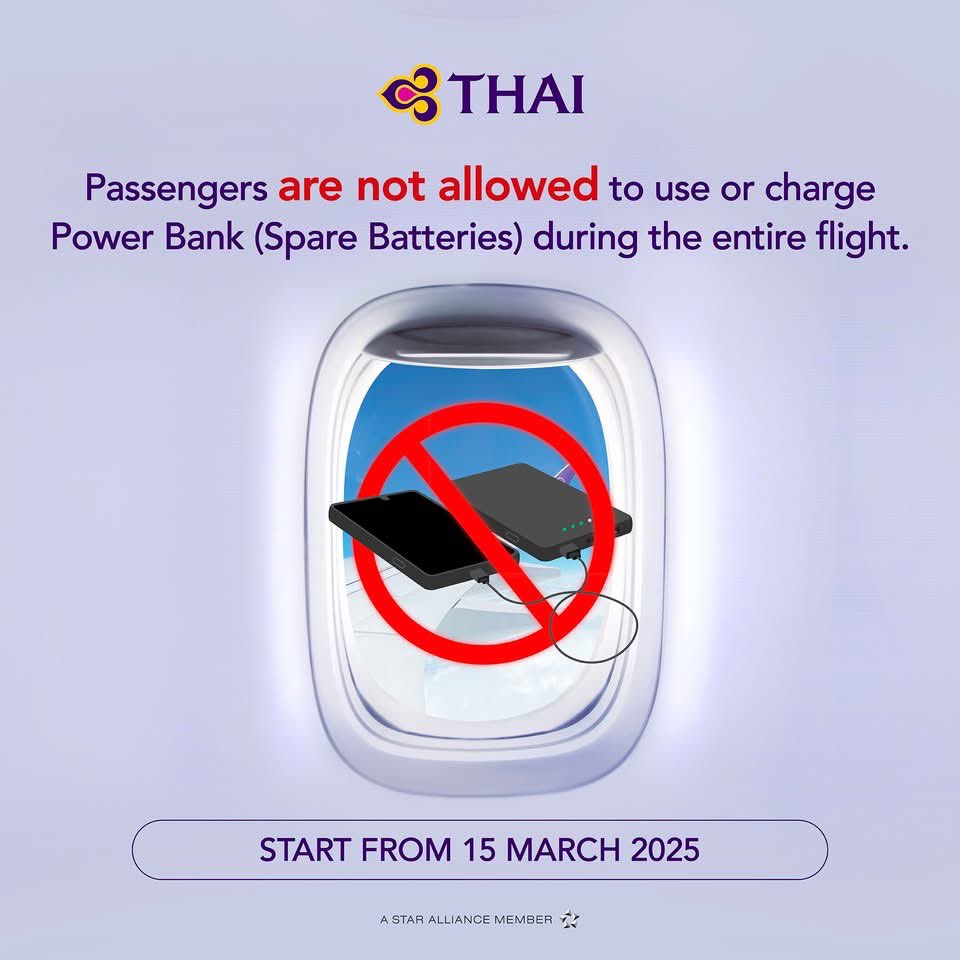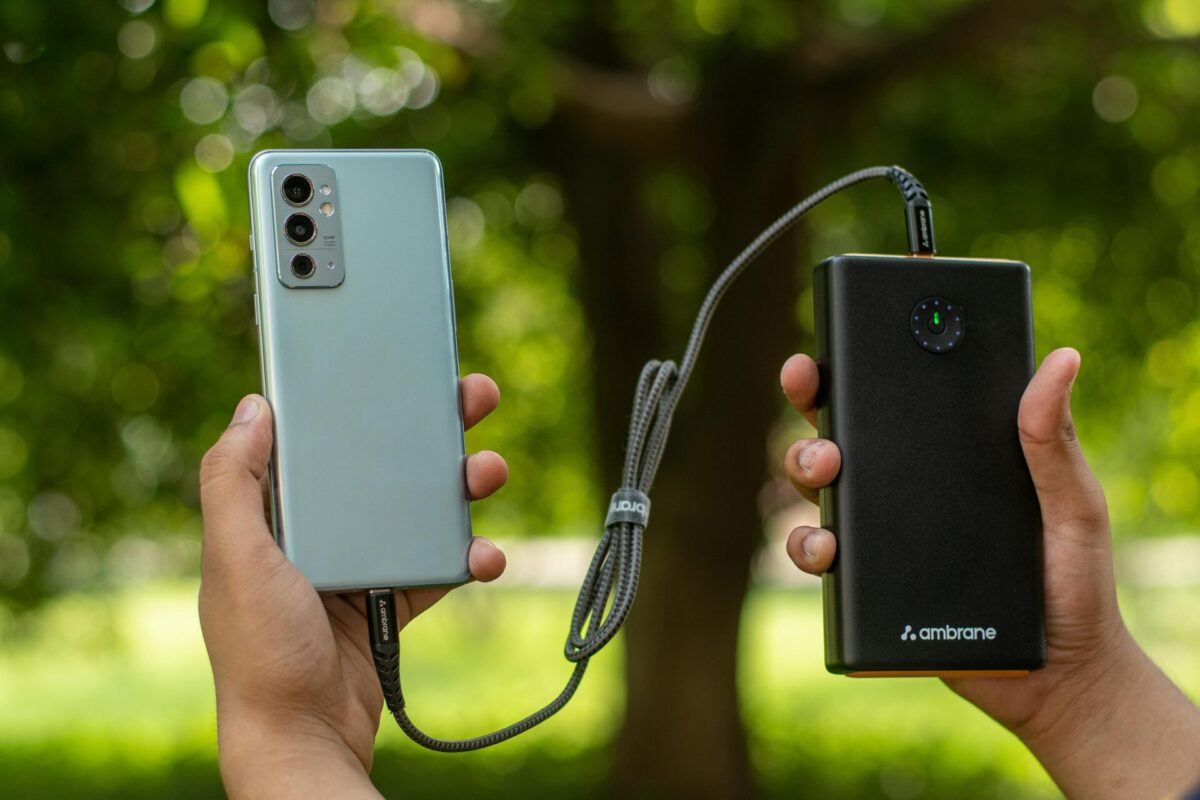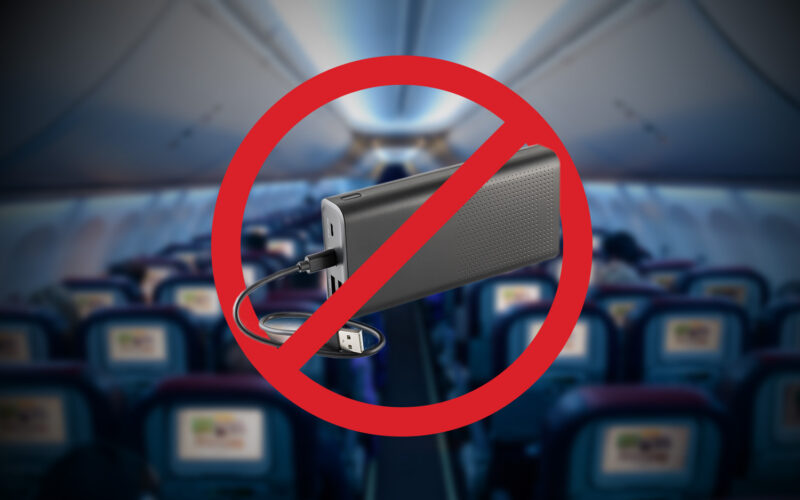Following a spate of incidents during early 2025, airlines have begun changing the rules on using and storing portable chargers, or ‘power banks,’ in flight. Some airlines are banning power banks in overhead compartments, while others are prohibiting the use of the devices during the flight.
If you’re due to travel soon and you’re not sure what you are and aren’t allowed to do with a power bank in flight, here’s what you need to know.
The airlines banning power banks
Several airlines have changed their guidance on carrying lithium batteries on planes, which are found in power banks, cellphones, and e-cigarettes. These batteries have the potential to malfunction and produce smoke, heat and even fire.
Below is a table of all the airlines so far confirmed to be changing the use of power banks on aircraft:
| Airline | Date of change | New rules |
| Singapore Airlines & Scoot | April 1, 2025 | Fully charge before flight, do not use in flight |
| EVA Air | March 1, 2025 | Fully charge before flight, do not use in flight |
| Thai Airways | March 15, 2025 | Fully charge before flight, do not use in flight |
| AirAsia | March 15, 2025 | Fully charge before flight, do not use in flight |
| China Airlines | March 1, 2025 | Fully charge before flight, do not use in flight |
| Air Busan | February 5, 2025 | Do not store in overhead locker, fully charge before flight, do not use in flight |
| Korean Air | March 1, 2025 | Do not store in overhead locker, fully charge before flight, do not use in flight |
| Asiana Airlines | March 1, 2025 | Do not store in overhead locker, fully charge before flight, do not use in flight |
| Starlux Airlines | Since 2018 | Fully charge before flight, do not use in flight |
| Tigerair Taiwan | March 1, 2025 | Fully charge before flight, do not use in flight |
| Cathay Pacific | April 7, 2025 | Do not store in overhead locker, fully charge before flight, do not use in flight |
| Hong Kong Airlines | April 7, 2025 | Do not store in overhead locker, fully charge before flight, do not use in flight |
First to implement a new ban on power banks was Air Busan, following a terrifying fire onboard. While many airlines are no longer allowing passengers to use power banks on flights, Air Busan has gone a step further, requiring that passengers keep such devices on their person, preferably in a seat pocket.
In fact, all South Korean airlines have now adopted the same policy. Although we only mentioned major carriers here, the ban also affects Air Premia, Air Seoul, T’Way Air, Jeju Air and all other South Korean carriers. The idea is that, by having the device near you and visible, any malfunction can be rapidly identified and dealt with.
According to Dimsum Daily, all Hong Kong airlines will soon implement the same rules. From April 7, all HK airlines will no longer allow the use of power banks or storage in overhead compartments during flights. As well as Cathay and Hong Kong Airlines, this rule will affect Greater Bay Airlines and HK Express, plus charter airlines operating in Hong Kong.
Many other Asian airlines have moved to ban the use of power banks in flight, although storage in an overhead compartment is still permitted. Taiwanese carrier Starlux has maintained this policy since its launch in 2018, but is now being joined by many major carriers in the region.

As yet, no US or Western airline has announced any changes to the use of power banks in flight. ICAO and IATA have not altered their guidance for lithium battery carriage, but that could change in the future. As always, check with your airline before flying if you’re unsure of the rules.
Are power banks banned on flights?
Passengers are not banned from bringing power banks onto aircraft, but many airlines are now restricting how they are stored and whether they can be used during the flight.
Since 2015, airlines have banned power banks from checked-in luggage, but have allowed passengers to bring them onboard in hand luggage. However, many airlines have restricted the size of the power bank you can bring on your flight.
Most airlines now allow power banks up to 100 Wh to be brought onboard. Depending on the voltage of your power bank, this usually means you can bring a device labelled up to 27,000 mAh in your carry-on luggage. Some airlines allow devices of up to 160 Wh (43,000 mAH) with prior approval. Devices with higher capacity than this are not typically allowed on flights at all.

Airlines are now asking passengers not to use their power bank to charge any devices during the flight, directing them to use the USB charging at their seat instead. Similarly, passengers are not allowed to recharge the power bank from an aircraft’s USB outlet.
Some airlines are requiring passengers to remove their power banks from bags and keep them in a seat pocket. They also advise insulating the terminals to avoid a short circuit.
Why are airlines banning power banks now?
The increased attention to personal charging devices has come in the wake of several alarming events involving lithium batteries.
Devices containing lithium batteries, including power banks and mobile phones, are at risk of a thermal runaway. This is where the heat generated inside the battery exceeds the amount that can be safely dissipated, causing a chain reaction that can result in smoke, fire or even an explosion.
The buildup of heat can begin due to overcharging, physical damage, a short circuit or even manufacturing defects. As the heat begins to build, it weakens the separator between the battery’s anode and cathode, increasing the risk of an internal short circuit. As the temperature continues to rise, the battery swells, releasing toxic and flammable gasses.
According to the FAA, lithium battery fires on US flights have risen 388% since 2015. New incidents are reported almost twice a week, and that’s just in the USA. The prime culprit is the power bank, the root of 43% of all reports. E-cigarettes were second worst with 20%, while laptops, phones and other devices represented around 12% of incidents.
In January, a fire on an Air Busan Airbus A321, which was later determined to be caused by a faulty power bank, destroyed the aircraft. The passengers and crew were evacuated safely, but the severity of the incident prompted Air Busan, and later all South Korean airlines, to change the rules.
More recently, in early March, a Batik Air flight filled with smoke after a power bank overheated as the flight was landing. Cabin crew were filmed checking overhead compartments for the source of the smoke, finally placing the device in a safe box to allow the flight to land safely.
And just a few days ago, on March 20, a Hong Kong Airlines A320 had to divert moments after takeoff when a lithium battery caught fire in an overhead bin. This incident prompted Hong Kong’s aviation authority to implement a ban on storing power banks overhead as from April 7.
These are just a handful of examples of emergencies airlines are dealing with every day around the world. With people carrying more battery-powered devices than ever, there could be as many as 1,000 lithium batteries on board any single airliner, each one bringing a risk of fire and explosion.
Cabin crew are trained to deal with lithium battery fires in flight, and carry safe boxes or containment bags to control the situation. Though global regulators have stopped short of trying to ban batteries entirely, passengers should not travel with damaged, uncharged or faulty devices, or those that exceed the maximum wattage.
Why can’t power banks be checked in?
Regulators and airlines began banning power banks from checked luggage in 2015, following updated guidance from ICAO, the FAA and IATA.
Given the risk of thermal runaways in lithium batteries, not having them in the cargo hold makes sense. Fires in cargo holds are much harder to detect and deal with than those in the passenger cabin.
In 2010, a UPS Boeing 747 crashed shortly after takeoff due to a fire in the cargo hold. It was later found that a lithium battery had started the fire. In 2011, Asiana Airlines’ Boeing 747 cargo aircraft crashed into the sea after reporting a fire in the cargo hold. The aircraft was carrying lithium batteries.
Having learnt from these incidents, no airline will allow you to check your power bank for a flight, or indeed any device containing a lithium battery. This includes laptops, tablets, mobile phones and camera equipment.
Tips for keeping your power bank safe on a flight
If you need to take your power bank on a flight, you can stay safe by:
- Using a high quality device: Buying from reputable brands with safety certifications will ensure that the manufacturing is of good quality
- Pack it well: Crushed or corrupted power banks are more likely to experience a thermal runaway, so pack securely to avoid damage
- Don’t overcharge it: Unplug your power bank once charged, and don’t charge it on the plane
- Bring it charged: Fully charged batteries are much more stable than depleted devices, so try to charge it fully before getting on the plane
- Don’t use it while it’s charging: Using the power bank while it’s also being charged, also known as ‘pass through charging’, increases the heat load and risk
- Keep it out of the overhead bin: Although not all airlines require you to retain your power bank on your person, it’s a good idea to keep an eye on it during your flight, so put it in a seat pocket where you can rapidly spot any problems
Although we’re specifically talking about power banks here, these tips and rules apply for any device using a lithium battery, including your cell phone. If you lose your phone or power bank in your seat, don’t attempt to get it back. Let the crew know and follow all their instructions to keep you and the rest of the passengers safe.

